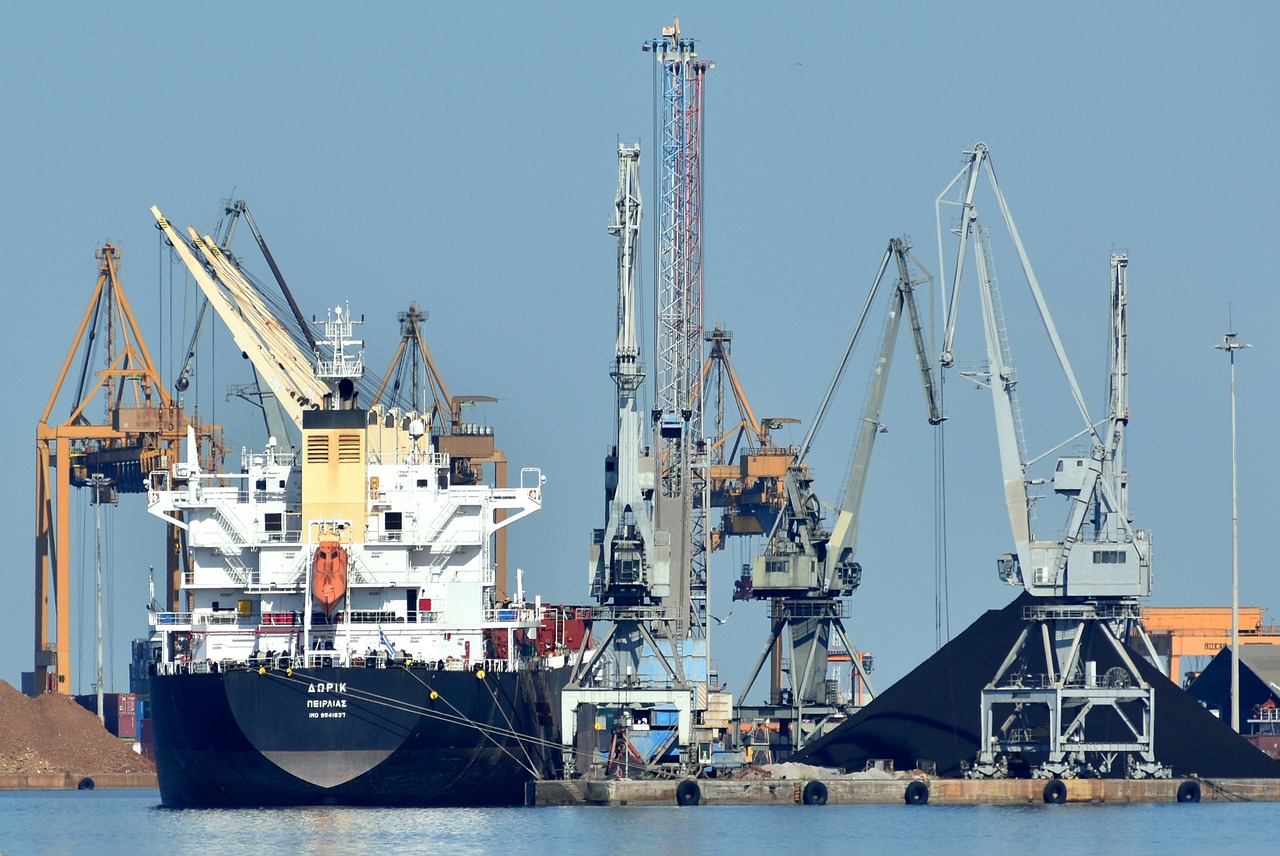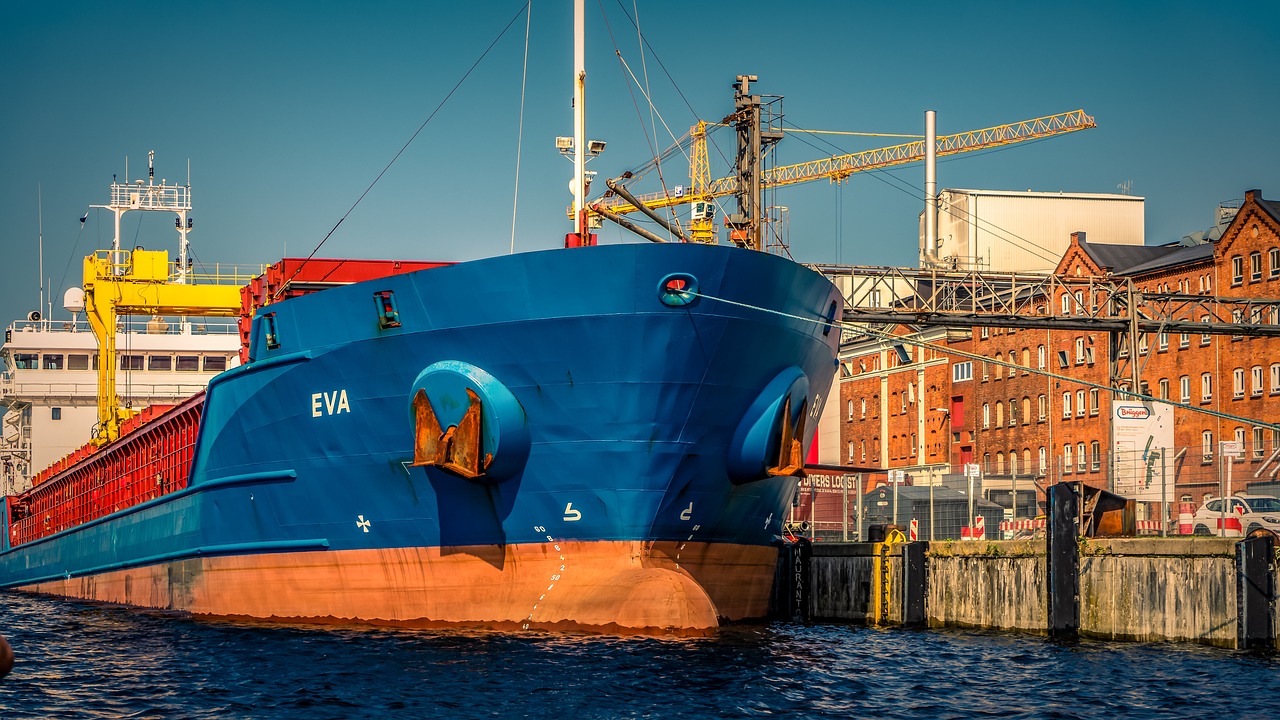How Technology is Influencing Global Trade
In today's interconnected world, technology has become the backbone of global trade, reshaping how businesses operate and interact across borders. The emergence of digital platforms, advanced logistics, and data-driven strategies has not only streamlined operations but also opened up a plethora of opportunities for companies of all sizes. Have you ever wondered how a small business in a remote corner of the world can now sell its products to customers halfway around the globe? This is the magic of technology in trade!
From the rise of e-commerce giants to the intricate web of supply chains powered by cutting-edge technology, the landscape of global trade is evolving at a breakneck pace. Businesses are no longer confined to local markets; instead, they can reach a global audience with just a few clicks. This transformation is not merely a trend but a fundamental shift that is redefining commerce as we know it.
As we delve deeper into this topic, we'll explore the various facets of how technology is influencing global trade, including the rise of e-commerce, innovations in supply chain management, the role of artificial intelligence, and the challenges that accompany this digital revolution. Buckle up as we embark on a journey through the exciting world of global trade and technology!
The digital marketplace has exploded in recent years, thanks to the rise of e-commerce. Gone are the days when consumers were limited to shopping within their geographical confines. Now, with just a smartphone or computer, customers can browse products from around the world. This has opened up a whole new realm of possibilities for businesses, particularly small and medium enterprises (SMEs).
Consider the following points about e-commerce:
- Global Reach: Businesses can now tap into international markets, reaching customers they never thought possible.
- Lower Barriers to Entry: E-commerce platforms provide SMEs with the tools to compete with larger corporations without the need for extensive physical infrastructure.
- Consumer Insights: Online sales enable businesses to gather valuable data about consumer preferences, helping them tailor their offerings more effectively.
In essence, e-commerce is not just a trend; it’s a revolution that has made the world a smaller place, allowing businesses to connect with customers in ways that were once unimaginable.
Technology has also significantly enhanced the efficiency of supply chains. With advancements such as automation, real-time tracking, and data analytics, businesses can streamline their operations and respond swiftly to changing market demands. Imagine a world where a company can monitor its inventory levels in real-time, predict shortages, and reorder supplies before they run out. This is not a distant dream but a reality made possible by technology.
One of the most groundbreaking innovations in recent years is blockchain technology. By providing a secure and transparent method for recording transactions, blockchain enhances trust among trading partners. It reduces fraud and improves traceability, making it a game-changer in global trade.
Building on the capabilities of blockchain, smart contracts automate and enforce agreements between parties. This means less reliance on intermediaries, leading to faster transactions and reduced costs in international trade agreements. Think of it as a digital handshake that ensures everyone holds up their end of the bargain without the need for a middleman.
Moreover, data analytics empowers businesses to gain insights into market trends and consumer behavior. With this information, companies can make informed decisions, optimize their trading strategies, and stay ahead of the competition. It’s like having a crystal ball that helps businesses navigate the ever-changing landscape of global trade.
Another significant player in the tech revolution is artificial intelligence (AI). AI technologies are being utilized to predict market trends, optimize logistics, and enhance customer service. By analyzing vast amounts of data, AI can help businesses identify patterns and make proactive decisions. This not only improves operational efficiency but also provides a competitive edge in the fast-paced world of global trade.
While the benefits of technology in global trade are undeniable, it’s essential to acknowledge the challenges that come with it. Issues such as cybersecurity threats, regulatory compliance, and the digital divide can pose significant hurdles for businesses looking to thrive in the digital marketplace.
As businesses become more reliant on digital platforms, they face heightened cybersecurity risks. Protecting sensitive data and maintaining customer trust are critical for sustaining successful global trade operations. Companies must invest in robust security measures to safeguard their digital assets.
Navigating the complex landscape of international regulations can be challenging for businesses. Understanding and adhering to various compliance requirements is essential for successful digital trade and avoiding legal pitfalls. This complexity can deter smaller businesses from entering the global market.
Looking ahead, the future of global trade will be shaped by continued technological advancements. Emerging technologies like the Internet of Things (IoT) and 5G will further enhance connectivity and efficiency, driving new business models and opportunities worldwide. As we embrace these innovations, businesses must stay agile and adaptable to thrive in an ever-evolving landscape.
- How is technology changing global trade? Technology is streamlining operations, enhancing communication, and providing businesses with tools to reach global markets.
- What are the main challenges of digital trade? Cybersecurity threats, regulatory compliance, and the digital divide are significant challenges businesses face in the digital marketplace.
- How can small businesses benefit from e-commerce? E-commerce allows small businesses to reach a global audience, reduce operational costs, and gain valuable consumer insights.

The Rise of E-commerce
E-commerce has truly revolutionized the way we think about shopping and doing business on a global scale. Gone are the days when consumers were limited to local shops and markets; now, with just a few clicks, you can purchase products from the other side of the world! This shift has opened up a treasure trove of opportunities, especially for small and medium enterprises (SMEs) that previously struggled to compete with larger corporations. The digital marketplace has leveled the playing field, allowing these businesses to reach customers far beyond their geographical boundaries.
Imagine a small artisan in a remote village, crafting beautiful handmade goods. Before the rise of e-commerce, their market was limited to local buyers. Now, through platforms like Etsy or Amazon, they can showcase their products to a global audience, tapping into new customer bases that were once unimaginable. This democratization of commerce has not only empowered individual entrepreneurs but has also sparked a wave of innovation and creativity in how products are marketed and sold.
Furthermore, the convenience of online shopping cannot be overstated. Consumers now enjoy the ability to shop at any time of day or night, compare prices instantly, and have products delivered right to their doorstep. This shift in consumer behavior has forced traditional brick-and-mortar stores to adapt or risk obsolescence. Many have embraced an omnichannel strategy, integrating their online and offline operations to enhance the customer experience.
As we delve deeper into the world of e-commerce, it's essential to acknowledge the role of technology in facilitating this growth. From secure payment gateways to advanced logistics solutions, technology has become the backbone of online retail. For instance, the use of AI-driven algorithms helps businesses personalize shopping experiences, recommending products based on previous purchases or browsing history. This level of personalization not only enhances customer satisfaction but also drives sales.
However, it's not all smooth sailing in the e-commerce landscape. While the opportunities are vast, businesses must navigate challenges such as intense competition, cybersecurity threats, and the need for effective digital marketing strategies. To succeed, they must be agile and willing to adapt to the ever-changing market dynamics.
In summary, the rise of e-commerce has transformed the global trading landscape, enabling businesses of all sizes to participate in the digital economy. As technology continues to evolve, it will be exciting to see how e-commerce adapts and grows, paving the way for new innovations and opportunities.

Supply Chain Innovations
The landscape of global trade is undergoing a remarkable transformation, largely driven by technological innovations in supply chain management. These advancements are not just about making things faster; they are about making operations more efficient, transparent, and responsive to the ever-changing market demands. Imagine a world where businesses can track their shipments in real-time, predict potential disruptions before they happen, and automate mundane tasks that typically consume valuable resources. This is the new reality that technology is creating.
One of the most significant innovations in supply chains is the rise of automation. Automated systems streamline processes by minimizing human intervention, thereby reducing errors and speeding up operations. For instance, warehouses equipped with automated picking systems can fulfill orders at lightning speed, ensuring that products reach customers faster than ever before. This efficiency not only enhances customer satisfaction but also boosts the bottom line for businesses.
Real-time tracking is another game-changer in supply chain management. With GPS and RFID technology, businesses can monitor the location and status of their goods throughout the entire shipping process. This level of transparency is invaluable. It allows companies to provide accurate delivery estimates, manage inventory more effectively, and respond swiftly to any delays. Imagine being able to reassure a customer that their package is just a few miles away, thanks to real-time tracking data!
Among the most revolutionary technologies impacting supply chains is blockchain. This decentralized ledger system enhances trust and security by providing a transparent record of all transactions. For businesses engaged in global trade, this means that every shipment can be tracked from origin to destination, ensuring that all parties have access to the same information. This not only reduces the risk of fraud but also improves traceability, which is crucial in industries like food and pharmaceuticals where safety is paramount.
Another fascinating aspect of blockchain technology is the use of smart contracts. These self-executing contracts automatically enforce the terms of an agreement when certain conditions are met. This eliminates the need for intermediaries, which can slow down transactions and increase costs. For example, a smart contract could automatically release payment to a supplier once a shipment is confirmed as delivered. This not only speeds up the transaction process but also builds greater trust among trading partners.
Data analytics is yet another powerful tool in the supply chain arsenal. By analyzing vast amounts of data, businesses can gain insights into market trends and consumer behavior. This information is invaluable for making informed decisions. For instance, if data analytics reveals a spike in demand for a particular product, companies can adjust their supply chains accordingly to avoid stockouts. This proactive approach is essential in today’s competitive landscape.
Artificial Intelligence (AI) is increasingly being leveraged to optimize logistics and enhance customer service. AI algorithms can analyze data patterns to predict market trends, helping businesses stay ahead of the curve. For instance, AI can forecast demand based on historical data and current market conditions, allowing companies to adjust their inventory levels proactively. This not only reduces costs associated with overstocking but also ensures that customers find what they need when they need it.
In conclusion, the innovations in supply chain management are not just about keeping pace with the competition; they are about redefining how businesses operate in a global marketplace. As technology continues to evolve, companies that embrace these changes will not only improve their operational efficiency but also enhance their ability to serve customers effectively. The future of global trade is bright, and it’s being powered by technology.
- What are the key technologies influencing supply chains today? Technologies such as automation, blockchain, AI, and data analytics are at the forefront of supply chain innovations.
- How does real-time tracking improve supply chain management? It enhances transparency, allows for accurate delivery estimates, and enables swift responses to delays.
- What role do smart contracts play in global trade? They automate and enforce agreements, reducing the need for intermediaries and speeding up transactions.
- Why is data analytics important for supply chains? It provides insights into market trends and consumer behavior, enabling informed decision-making and optimized trading strategies.

Blockchain Technology
is like a digital ledger that records transactions in a way that is both secure and transparent. Imagine a giant notebook that everyone can see, but no one can erase or alter what’s been written. This innovative technology is transforming global trade by providing a method to track products and transactions from the point of origin to the final destination. This level of transparency not only builds trust among trading partners but also significantly reduces the chances of fraud and errors.
In the past, tracking the journey of goods across borders was a cumbersome process, often fraught with delays and misunderstandings. With blockchain, every transaction is recorded in real-time, allowing businesses to have a clear view of their supply chains. This means that if something goes wrong—like a shipment getting delayed or a product being tampered with—companies can quickly identify where the issue occurred and take action. It’s like having a GPS for your goods, ensuring they reach their destination safely and on time.
One of the most exciting aspects of blockchain is its ability to enhance traceability. For instance, in industries like food and pharmaceuticals, knowing the exact path a product has taken is crucial for safety and compliance. With blockchain, each step of the journey is documented, creating a reliable history that can be accessed by all stakeholders. This not only helps in recalling defective products but also reassures consumers about the authenticity and quality of their purchases.
Moreover, the implementation of blockchain can streamline processes by reducing the need for intermediaries. Traditionally, multiple parties are involved in international trade—think banks, customs agents, and logistics companies—each adding layers of complexity and cost. However, with blockchain, smart contracts can be utilized. These are self-executing contracts with the agreement directly written into code. They automatically enforce and execute the terms of a contract when certain conditions are met, which can lead to faster transactions and lower costs.
To illustrate the impact of blockchain in global trade, consider the following table:
| Aspect | Traditional Method | Blockchain Method |
|---|---|---|
| Transaction Time | Days to weeks | Minutes to hours |
| Cost | High due to intermediaries | Lower due to automation |
| Transparency | Limited visibility | Full visibility for all parties |
| Fraud Risk | Higher risk | Lower risk due to traceability |
In summary, blockchain technology is revolutionizing global trade by enhancing transparency, reducing costs, and improving efficiency. As more businesses adopt this technology, we can expect to see a significant shift in how international trade operates, making it faster, safer, and more reliable than ever before.
- What is blockchain technology? Blockchain technology is a decentralized digital ledger that records transactions across many computers in such a way that the registered transactions cannot be altered retroactively.
- How does blockchain improve transparency in global trade? Blockchain provides a public record of all transactions, allowing all parties to have access to the same information, thus enhancing trust and accountability.
- What are smart contracts? Smart contracts are self-executing contracts with the terms of the agreement directly written into code, which automatically enforce and execute when conditions are met.
- Can blockchain reduce fraud in trade? Yes, because blockchain allows for complete traceability of products, it significantly lowers the risk of fraud by making it easy to track the history and authenticity of goods.

Smart Contracts
Imagine a world where contracts execute themselves without the need for a middleman. are revolutionizing the way agreements are made in global trade by automating and enforcing the terms of a contract directly through code. These self-executing contracts operate on blockchain technology, ensuring that once conditions are met, actions are taken automatically. This not only speeds up transactions but also minimizes the potential for disputes, as the terms are clear and unchangeable.
One of the most compelling aspects of smart contracts is their ability to enhance efficiency in international trade. Traditional contracts often require extensive paperwork, multiple signatures, and a lengthy approval process. In contrast, smart contracts streamline this process significantly. For example, when a shipment is delivered and verified, a smart contract can automatically trigger payment to the supplier, eliminating the need for manual intervention. This can lead to substantial savings in both time and costs.
Furthermore, smart contracts contribute to greater transparency and trust among trading partners. Because these contracts are recorded on a blockchain, all parties have access to the same information, reducing the chances of misunderstandings or fraudulent activities. In a landscape where trust is paramount, the ability to verify transactions in real-time can be a game-changer. Here’s how smart contracts can enhance trust:
- Immutable Records: Once a smart contract is deployed, it cannot be altered, ensuring that all parties adhere to the agreed terms.
- Real-Time Updates: All stakeholders can view the status of the contract at any time, providing transparency throughout the trading process.
- Automated Compliance: Smart contracts can be programmed to ensure compliance with regulations, reducing the risk of legal issues.
However, while the advantages of smart contracts are significant, they are not without challenges. Issues such as coding errors, legal recognition, and the need for standardized protocols can pose hurdles. Businesses must ensure that the code is thoroughly tested and that all parties understand the implications of the contract. Moreover, as the global trade landscape evolves, regulatory bodies will need to establish clear frameworks for the use of smart contracts to ensure they are legally binding.
In conclusion, smart contracts represent a transformative force in global trade, offering efficiency, transparency, and trust. As businesses increasingly adopt this technology, they will not only enhance their operational capabilities but also pave the way for a more connected and automated trading environment. The future of trade is indeed bright, with smart contracts leading the charge towards more innovative practices.
- What are smart contracts? Smart contracts are self-executing contracts with the terms of the agreement directly written into code, which operate on blockchain technology.
- How do smart contracts enhance efficiency? They automate processes, reducing the need for intermediaries and speeding up transaction times.
- Are smart contracts legally binding? The legal status of smart contracts varies by jurisdiction, and businesses should ensure compliance with local laws.
- What are the risks associated with smart contracts? Risks include coding errors, lack of legal recognition, and challenges in standardization.

Data Analytics
In today's fast-paced global trade environment, has emerged as a game-changer, transforming the way businesses operate and make decisions. Imagine navigating a vast ocean without a compass—this is how companies once approached the market. Now, with the power of data analytics, businesses can chart their course with precision, leveraging insights derived from vast amounts of data to inform their strategies. The ability to analyze consumer behavior, market trends, and operational efficiencies not only enhances decision-making but also fosters a culture of continuous improvement.
At its core, data analytics involves collecting, processing, and analyzing data to uncover patterns and insights that can drive business performance. For instance, companies can utilize advanced analytics to:
- Predict Consumer Behavior: By analyzing past purchasing patterns, businesses can forecast future demand, allowing them to stock inventory more efficiently and tailor marketing strategies.
- Optimize Supply Chains: Data analytics helps identify bottlenecks and inefficiencies in supply chains, enabling companies to streamline operations and reduce costs.
- Enhance Customer Experience: By understanding customer preferences and feedback, businesses can personalize their offerings, leading to higher customer satisfaction and loyalty.
Moreover, the integration of data analytics in global trade is not just beneficial; it's essential for survival in a competitive landscape. Companies that embrace data-driven decision-making are more agile and capable of adapting to changing market conditions. For example, during the recent global disruptions caused by the pandemic, businesses that leveraged data analytics to understand shifting consumer behavior were better positioned to pivot their strategies and maintain their market presence.
But it’s not just about having data; it’s about how you use it. Companies need to invest in the right tools and technologies to harness the full potential of data analytics. This includes employing machine learning algorithms that can process vast datasets in real-time, providing actionable insights at unprecedented speeds. Additionally, businesses must ensure they have the right talent in place—data scientists and analysts who can interpret data and translate it into strategic initiatives.
In conclusion, as we look to the future of global trade, the role of data analytics will only become more pronounced. Companies that prioritize data-driven strategies will not only survive but thrive in an ever-evolving marketplace. The journey towards becoming a data-centric organization may seem daunting, but the rewards—enhanced efficiency, improved customer satisfaction, and greater profitability—are well worth the effort.
- What is data analytics?
Data analytics is the process of collecting, processing, and analyzing data to uncover insights that can help businesses make informed decisions. - How can data analytics improve global trade?
By providing insights into market trends and consumer behavior, data analytics helps businesses optimize their strategies, enhance supply chain efficiency, and improve customer experiences. - What tools are commonly used for data analytics?
Common tools include statistical software, business intelligence platforms, and machine learning frameworks that help analyze and visualize data. - Is data analytics only for large companies?
No, data analytics can benefit businesses of all sizes. Small and medium enterprises can leverage affordable analytics tools to gain a competitive edge.

Artificial Intelligence in Trade
Artificial Intelligence (AI) is not just a buzzword; it’s a game changer in the world of global trade. Imagine having a super-smart assistant that can analyze vast amounts of data in seconds, predict trends, and even suggest the best moves for your business. That's what AI brings to the table! It’s like having a crystal ball for market trends, enabling businesses to stay ahead of the curve.
One of the most exciting applications of AI in trade is its ability to optimize logistics. With AI algorithms, businesses can analyze shipping routes, weather patterns, and traffic conditions to determine the most efficient paths for transporting goods. This not only saves time and money but also reduces carbon footprints, making logistics smarter and more sustainable. For example, AI can help companies decide whether to ship via air or sea based on cost, urgency, and environmental impact.
Moreover, AI enhances customer service in ways we could only dream of a few years ago. Chatbots powered by AI can handle customer inquiries 24/7, providing instant responses and freeing up human agents for more complex issues. This means that businesses can maintain high levels of customer satisfaction while reducing operational costs. The ability to analyze customer interactions also allows businesses to tailor their offerings to meet specific needs, creating a personalized shopping experience that keeps customers coming back.
AI is also instrumental in predictive analytics. By examining historical data and market trends, AI can forecast demand for products, helping businesses manage their inventory more effectively. This is crucial in avoiding overstock situations or stockouts, which can lead to lost sales and dissatisfied customers. For instance, a retailer can use AI to analyze shopping patterns during holiday seasons, adjusting their inventory accordingly to meet expected spikes in demand.
However, while the benefits of AI in trade are vast, businesses need to be mindful of the challenges that come with it. Data privacy and ethical considerations are paramount as companies collect and analyze consumer data. Striking a balance between leveraging AI for competitive advantage and respecting consumer rights is essential. As we move forward, the integration of AI in trade will continue to evolve, shaping the future of global commerce in ways we can only begin to imagine.
- What is the role of AI in global trade?
AI plays a crucial role in optimizing logistics, enhancing customer service, and providing predictive analytics, which helps businesses make informed decisions. - How does AI improve logistics?
AI analyzes various factors such as shipping routes, weather, and traffic to determine the most efficient way to transport goods, saving time and costs. - Can AI help with customer service?
Yes! AI-powered chatbots can provide instant responses to customer inquiries, improving customer satisfaction and reducing operational costs. - What are the ethical concerns surrounding AI in trade?
Data privacy is a major concern, as businesses must ensure they are collecting and using consumer data responsibly and ethically.

Challenges of Digital Trade
The digital revolution has undoubtedly transformed the landscape of global trade, but it hasn't come without its fair share of challenges. As businesses increasingly rely on technology to facilitate their operations, they encounter a myriad of obstacles that can impede their growth and success in the digital marketplace. One of the most pressing issues is cybersecurity risks. With the rise of e-commerce and online transactions, companies are becoming prime targets for cybercriminals. Data breaches, identity theft, and ransomware attacks can lead to significant financial losses and damage to a company's reputation. Protecting sensitive information is not just a technical requirement; it is a fundamental necessity for maintaining customer trust and sustaining successful global trade operations.
Moreover, navigating the complex landscape of regulatory compliance poses another significant challenge. Different countries have varying laws and regulations governing online trade, data protection, and consumer rights. For instance, the General Data Protection Regulation (GDPR) in Europe imposes strict guidelines on how businesses can handle personal data. Companies operating across borders must invest considerable time and resources to understand and comply with these regulations, which can be a daunting task. Failure to comply can lead to hefty fines and legal repercussions, further complicating the global trading process.
Another challenge is the digital divide. While technology has opened doors for many, it has also highlighted disparities in access to digital resources. Small and medium enterprises (SMEs) in developing countries often struggle to compete on a global scale due to limited internet access, lack of digital skills, and insufficient infrastructure. This divide can hinder equitable access to global markets and limit opportunities for growth and innovation.
To illustrate the challenges faced by businesses in digital trade, consider the following table that summarizes the key issues:
| Challenge | Description |
|---|---|
| Cybersecurity Risks | Increased vulnerability to cyberattacks, leading to data breaches and loss of customer trust. |
| Regulatory Compliance | Complex international regulations requiring businesses to adapt to various legal frameworks. |
| Digital Divide | Disparities in access to technology and digital resources, limiting opportunities for SMEs. |
In conclusion, while technology continues to reshape global trade, businesses must remain vigilant in addressing these challenges. By investing in robust cybersecurity measures, staying informed about regulatory changes, and advocating for greater access to technology, companies can better position themselves to thrive in the evolving digital landscape.
- What are the main cybersecurity risks in digital trade? Cybersecurity risks include data breaches, identity theft, and ransomware attacks that can compromise sensitive information.
- How can businesses ensure compliance with international regulations? Businesses can ensure compliance by staying informed about the regulations in each country they operate in and investing in legal counsel to navigate complex laws.
- What is the digital divide, and how does it affect global trade? The digital divide refers to the gap between those with easy access to digital technology and those without. It affects global trade by limiting opportunities for businesses in developing countries.

Cybersecurity Risks
In this digital age, where technology reigns supreme, have become a pressing concern for businesses engaged in global trade. As companies increasingly rely on digital platforms to conduct their transactions, they expose themselves to a myriad of threats that can jeopardize their operations and customer trust. Imagine a bustling marketplace where every transaction is monitored and recorded, yet lurking in the shadows are hackers ready to exploit vulnerabilities. This scenario is not far from reality in the world of digital trade.
One of the most alarming aspects of cybersecurity is the rise of data breaches. These breaches can lead to the unauthorized access of sensitive information, including customer data, financial records, and trade secrets. According to recent studies, a significant percentage of businesses have experienced some form of data breach, which can result in devastating financial losses and reputational damage. Just think about it: a single incident can unravel years of trust built with customers and partners.
Furthermore, the complexity of digital transactions introduces additional vulnerabilities. With multiple stakeholders involved—suppliers, logistics providers, payment processors—each connection can serve as a potential entry point for cybercriminals. This is particularly concerning for small and medium enterprises (SMEs), which may lack the resources to implement robust cybersecurity measures. In fact, a recent survey revealed that SMEs are often targeted more frequently than larger corporations, as hackers perceive them as easier targets.
To combat these threats, businesses must adopt a proactive approach to cybersecurity. Here are some essential strategies that can help mitigate risks:
- Regular Security Audits: Conducting routine assessments of your cybersecurity infrastructure can help identify weaknesses before they are exploited.
- Employee Training: Educating employees about the importance of cybersecurity and best practices can significantly reduce the risk of human error, which is often the weakest link in security.
- Implementing Strong Password Policies: Encouraging the use of complex passwords and enabling two-factor authentication can add an extra layer of security to sensitive accounts.
Moreover, investing in advanced cybersecurity technologies, such as artificial intelligence and machine learning, can enhance threat detection and response capabilities. These technologies can analyze patterns and identify anomalies in real time, allowing businesses to react swiftly to potential threats.
In conclusion, while the digital landscape offers remarkable opportunities for global trade, it also presents significant cybersecurity challenges. Businesses must remain vigilant and proactive in safeguarding their digital assets. After all, in the world of trade, trust is invaluable, and a single breach can shatter that trust in an instant.
Q: What are the most common cybersecurity threats faced by businesses in global trade?
A: The most common threats include data breaches, phishing attacks, ransomware, and insider threats, all of which can compromise sensitive information.
Q: How can businesses improve their cybersecurity posture?
A: Businesses can improve their cybersecurity by conducting regular security audits, training employees, implementing strong password policies, and investing in advanced cybersecurity technologies.
Q: Are small businesses more vulnerable to cyber attacks?
A: Yes, small businesses are often seen as easier targets due to limited resources for cybersecurity measures, making them more vulnerable to attacks.

Regulatory Compliance
In the fast-evolving landscape of global trade, has become a critical concern for businesses of all sizes. As companies expand their operations across borders, they encounter a complex web of regulations that govern international trade. These regulations can vary significantly from one country to another, encompassing everything from import/export laws to tax obligations and labor standards. Navigating this intricate maze can feel like trying to find your way through a dense fog, where one misstep could lead to costly penalties or even legal repercussions.
To thrive in this environment, businesses must not only understand the regulations that apply to their operations but also stay updated on any changes. This requires a proactive approach, often involving the establishment of dedicated compliance teams or partnerships with legal experts who specialize in international trade law. For instance, companies may need to comply with regulations set forth by organizations such as the World Trade Organization (WTO) or adhere to specific trade agreements, like the North American Free Trade Agreement (NAFTA), now known as the United States-Mexico-Canada Agreement (USMCA).
Moreover, the rise of digital trade has introduced additional layers of complexity. Businesses must grapple with data protection laws such as the General Data Protection Regulation (GDPR) in Europe, which imposes strict requirements on how companies handle personal data. Failure to comply with such regulations can result in hefty fines and damage to a company's reputation. Therefore, companies must invest in robust compliance frameworks that not only address existing regulations but also anticipate future changes.
To illustrate the various aspects of regulatory compliance, consider the following table that outlines some common compliance challenges faced by businesses engaged in global trade:
| Compliance Challenge | Description |
|---|---|
| Import/Export Regulations | Understanding tariffs, quotas, and documentation requirements for goods entering or leaving a country. |
| Tax Compliance | Navigating different tax laws and ensuring proper filing and payment in multiple jurisdictions. |
| Data Protection | Adhering to regulations governing the collection and storage of personal data, particularly in the EU. |
| Labor Standards | Ensuring compliance with labor laws and regulations that protect workers' rights in various countries. |
Ultimately, the key to successful regulatory compliance lies in education and adaptability. Businesses must cultivate a culture of compliance, where employees are trained to recognize and address regulatory issues as they arise. This not only minimizes the risk of non-compliance but also fosters a sense of accountability within the organization. As the landscape of global trade continues to shift, those who remain vigilant and responsive to regulatory changes will be better positioned to seize opportunities and mitigate risks.
- What is regulatory compliance in global trade? Regulatory compliance refers to the adherence to laws, regulations, and guidelines that govern international trade activities.
- Why is regulatory compliance important? It is crucial to avoid legal penalties, ensure smooth operations across borders, and maintain a good reputation in the market.
- How can businesses stay compliant with regulations? Businesses can stay compliant by investing in compliance training, hiring legal experts, and utilizing technology to monitor regulatory changes.

The Future of Global Trade
The future of global trade is poised to be a thrilling ride, driven by the relentless march of technology. Imagine a world where businesses can operate seamlessly across borders, leveraging cutting-edge innovations to enhance their operations and reach new markets. As we look ahead, several key trends are emerging that will redefine how trade is conducted globally. These trends are not just about convenience; they are about creating a more interconnected and efficient global marketplace.
One of the most significant advancements on the horizon is the integration of the Internet of Things (IoT). This technology will enable businesses to connect devices and systems in real-time, allowing for smarter inventory management and logistics. Picture sensors on products that communicate their location and condition, ensuring that businesses can respond instantly to any disruptions in the supply chain. This level of connectivity will not only streamline operations but also enhance customer satisfaction, as consumers will be able to track their orders with unprecedented accuracy.
Additionally, the rollout of 5G technology is set to revolutionize global trade. With faster internet speeds and improved connectivity, businesses will be able to share data and communicate more effectively than ever before. This will facilitate quicker decision-making and more agile responses to market changes. Imagine a scenario where a retailer can instantly adjust its inventory based on real-time sales data streamed from connected devices. The speed and efficiency gained from 5G will empower businesses to innovate and adapt in a rapidly changing environment.
Moreover, the rise of artificial intelligence (AI) will continue to play a pivotal role in shaping the future of global trade. AI technologies will not only help predict market trends but also optimize logistics and enhance customer service. For instance, AI-driven algorithms can analyze vast amounts of data to identify emerging consumer preferences, allowing businesses to tailor their offerings accordingly. This predictive capability will give companies a competitive edge, enabling them to stay ahead of the curve in a crowded marketplace.
However, as we embrace these technological advancements, we must also consider the implications for regulatory frameworks. With the rapid evolution of technology, governments and international organizations will need to adapt their regulations to ensure fair and equitable trade practices. This will involve striking a balance between fostering innovation and protecting consumers and businesses from potential risks. The future of global trade will depend on collaboration between governments, businesses, and technology providers to create a regulatory environment that supports growth while safeguarding interests.
In conclusion, the future of global trade is bright and full of possibilities. With the integration of IoT, the advent of 5G, and the rise of AI, businesses will be better equipped to navigate the complexities of the global marketplace. However, it is essential to remain vigilant about the challenges that accompany these advancements, particularly in terms of regulation and security. By embracing these changes and working collaboratively, we can create a more dynamic and inclusive global trade landscape that benefits everyone.
- What role does technology play in global trade? Technology streamlines processes, enhances communication, and improves efficiency, enabling businesses to operate more effectively across borders.
- How will IoT impact supply chains? IoT will provide real-time data on inventory and logistics, allowing businesses to respond quickly to changes and optimize their operations.
- What are the potential challenges of increased digital trade? Challenges include cybersecurity risks, regulatory compliance, and ensuring equitable access for all businesses.
- How can businesses prepare for the future of global trade? Businesses should invest in technology, stay informed about regulatory changes, and adopt flexible strategies to adapt to market shifts.
Frequently Asked Questions
- How has e-commerce changed global trade?
E-commerce has completely transformed the way goods are bought and sold across borders. It allows businesses, especially small and medium enterprises, to tap into global markets without the hefty investment traditionally required for international trade. This means anyone with a good product and an internet connection can reach customers worldwide!
- What role does blockchain play in global trade?
Blockchain technology is like a digital ledger that provides a secure and transparent way to record transactions. This enhances trust between trading partners and helps in reducing fraud. With blockchain, businesses can track their products from origin to destination, ensuring transparency and traceability in the supply chain.
- What are smart contracts, and how do they benefit international trade?
Smart contracts are self-executing contracts with the terms directly written into code. They automate processes between parties, which means fewer intermediaries are needed. This leads to faster transactions and lower costs, making international trade smoother and more efficient.
- How does data analytics impact trading strategies?
Data analytics provides businesses with valuable insights into market trends and consumer behavior. By analyzing this data, companies can make informed decisions and tailor their trading strategies to meet customer needs, giving them a significant edge in the competitive global market.
- What challenges does digital trade face?
Digital trade, while beneficial, comes with its own set of challenges. These include cybersecurity threats, which put sensitive data at risk, and regulatory compliance issues, where businesses must navigate a maze of international regulations to avoid legal pitfalls.
- How can businesses protect themselves against cybersecurity risks?
To safeguard against cybersecurity threats, businesses should implement robust security measures such as encryption, regular software updates, and employee training on data protection. Building a strong cybersecurity strategy is crucial for maintaining customer trust and ensuring smooth global trade operations.
- What does the future hold for global trade?
The future of global trade looks bright, with emerging technologies like the Internet of Things (IoT) and 5G set to enhance connectivity and efficiency. These advancements will drive new business models and opportunities, making it an exciting time for businesses looking to expand their reach.



















